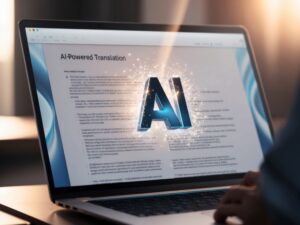Step-by-Step Guide to Building a Website with AI Tools
Building a website is a valuable endeavor in today’s digital age, as it is essential for almost everyone. Whether you want to share your thoughts and ideas through a blog, create a digital storefront to sell your products, or offer online courses, the process of building a website can help you achieve your goals. With the right tools and guidance, anyone can embark on the journey of building a website and establish a strong online presence.
However, the prospect of creating a website from scratch can be daunting, especially if you lack technical knowledge. Fortunately, with the advent of AI-powered tools, building a website has become more accessible than ever before.
In this article, we’ll explore seven AI-enabled tools that can help you get your website up and running quickly and easily, without requiring any coding skills. Let’s dive in!
We strongly recommend that you check out our guide on how to take advantage of AI in today’s passive income economy.
Table of Contents
1. Reloom: AI-Powered Website Mapping
Reloom (reloom.io) is a powerful tool that utilizes AI to map out your entire website. With their free plan, you can develop a simple website, while their premium plans cater to users of tools like Webflow and Figma.
To get started, create a new project in Reloom and enter a prompt describing your website’s purpose. For example, let’s say you’re creating a website about drones and drone reviews, helping people decide which drone best suits their needs.
Once you’ve entered your prompt, Reloom will generate a sitemap for you, complete with a homepage layout, featuring sections like a hero section, feature list, call-to-action, reviews, pricing, comparisons, testimonials, and FAQs.
You can also generate content for additional pages, such as an about us page, reviews, comparison guides, and contact us page. By clicking on each page, you can have Reloom generate the design and copy for that specific page.
Using AI, Reloom creates an entire sitemap with individual sections for each page, providing you with a solid foundation for building your website.
2. Hostinger: AI-Powered Website Hosting and Creation
Once you have your sitemap ready, you’ll need a reliable hosting provider. Hostinger is an excellent choice, offering affordable hosting plans starting at just $2.99 per month.
What sets Hostinger apart is its AI-powered website builder for WordPress. By selecting the Business Website Builder plan, you’ll gain access to a range of AI tools that can help you create your website quickly and easily.
When creating your website with Hostinger, you can choose to let AI generate your website in minutes. Simply provide your brand name, website type (e.g., blog), and a description of your website’s purpose.
Hostinger’s AI will then set everything up for you, creating a basic website with relevant images and content based on your input. From there, you can edit and customize your site further to suit your needs.
3. Color Mind: AI-Assisted Color Palette Selection
Building a website requires careful consideration of various design elements, and choosing the right color scheme is crucial for creating an attractive and cohesive look. When building a website, using Color Mind (colormind.io), a free tool that employs machine learning to generate well-coordinated color palettes, can be a game-changer. By utilizing Color Mind during the process of building a website, you can ensure that your site’s color scheme is visually appealing and enhances the overall user experience.
To use Color Mind, simply generate a random color palette to start. If you like a particular color, you can lock it in by clicking the lock button next to it. Color Mind will then generate other colors that complement your selected color.
Once you’ve found a color palette you love, you can copy the color codes and apply them to your website by editing the website styles in your Hostinger dashboard.
4. Font Joy: AI-Powered Font Pairing
In addition to colors, fonts play a significant role in your website’s overall design. Font Joy is an AI-powered tool that helps you find font pairings that work well together.
Similar to Color Mind, you can generate different font styles until you find a combination you like. If you particularly like one font, you can lock it in, and Font Joy will suggest complementary fonts to pair with it.
After selecting your desired fonts, head back to your website and update the font settings in the website styles section of your Hostinger dashboard.
5. ChatGPT and Claude: AI-Powered Content Creation
With your website’s design elements in place, it’s time to focus on creating compelling content. Two popular AI-powered tools for content creation are ChatGPT and Claude.
To generate content for your website, start by providing details about your site’s purpose and the type of content you need. For example, you can ask the AI to write a heading and subheading in the style of well-known marketers like Alex Hormozi or David Ogilvy.
The AI will then generate a heading and subheading based on your input, along with an explanation of why it chose those particular phrases. You can then copy and paste the generated content into the relevant sections of your website.
Repeat this process for each section of your website, ensuring that the content is engaging, informative, and aligned with your website’s overall purpose.
6. AI Image Generators: Enhancing Your Website’s Visuals
Visuals are a crucial component of any website, and AI image generators can help you create stunning, relevant images quickly and easily.
There are several AI image generators available, such as Midjourney, DALL-E 3, and Bing’s Image Creator. These tools allow you to generate images based on textual prompts, giving you a wide range of options to choose from.
For example, you can prompt an AI image generator to create an image of a camera drone flying above a city skyline. The AI will then generate several variations of the image, allowing you to select the one that best fits your website’s aesthetic.
Once you’ve generated the desired images, you can download them and upload them to your website, replacing any placeholder or default images.
7. Canva: AI-Assisted Featured Image Creation
Featured images are an essential element of blog posts, as they help attract clicks and engage readers. Canva is a user-friendly tool that allows you to create eye-catching featured images using AI-powered features.
To create a featured image in Canva, start by selecting a design template, such as a YouTube thumbnail, which has a similar aspect ratio to blog featured images.
Next, use Canva’s built-in image generator, “Magic Media,” to create images or graphics that match your blog post’s theme. For example, you can generate an image of a camera drone flying above a city skyline.
To make your featured image even more engaging, consider adding a personal touch by including an image of yourself. Canva’s AI-powered background remover can help you remove the background from your personal image, allowing you to seamlessly integrate it into the featured image.
Finally, add text to your featured image using fonts that match your website’s overall design. Canva offers a wide range of fonts, including the Roboto Condensed font we used earlier in our website creation process.
With a few simple steps, you can create a captivating featured image that complements your blog post and encourages readers to click through to your content.
Conclusion
Building a website from scratch can seem like a daunting task, but with the help of AI-powered tools, it’s never been easier. By leveraging tools like Reloom, Hostinger, Color Mind, Font Joy, ChatGPT, Claude, AI image generators, and Canva, you can create a professional-looking website without any coding knowledge.
Remember, while these AI tools can significantly streamline the process of building a website, they may not yield a perfectly polished site right away. However, with a little extra effort and fine-tuning, you can create a website that rivals those of well-established companies.
As AI technology continues to advance, the possibilities for building a website with AI tools are only going to expand. By staying up-to-date with the latest tools and trends, you can harness the power of AI to create a website that effectively showcases your brand, products, or ideas.
So, whether you’re a blogger, entrepreneur, or simply someone looking to establish an online presence, don’t let a lack of technical knowledge hold you back. Embrace the potential of AI and start building your website today!
Frequently Asked Questions (FAQs)
How much will it cost to build a website?
The cost of building a website can vary greatly depending on your specific needs and the tools you choose to use. While some AI-powered tools offer free plans, others may require a subscription or one-time payment.
For example, Hostinger’s Business Website Builder plan, which includes AI-assisted website creation, starts at $2.99 per month. However, this price can vary based on the length of your subscription and any additional features you may need.
It’s important to consider your budget and the features you require when selecting the tools to build your website. Keep in mind that while using AI tools can significantly reduce costs compared to hiring a professional developer, there may still be some expenses involved.
Can I build my own website for free?
Yes, it is possible to build your own website for free using various AI-powered tools. Many of the tools mentioned in this article, such as Reloom, Color Mind, Font Joy, and Canva, offer free plans or have free versions available.
However, keep in mind that free plans may come with limitations, such as reduced features, limited storage, or restrictions on the number of pages you can create. Additionally, you may need to pay for web hosting to make your website accessible to others on the internet.
Despite these limitations, using free AI tools can be a great way to get started with building your own website, especially if you’re on a tight budget or just want to experiment with website creation.
How can I create my own website?
Creating your own website using AI tools involves several steps, which we’ve outlined in detail throughout this article. Here’s a brief summary:
- Use Reloom to generate a sitemap and page layouts for your website.
- Choose a web hosting provider like Hostinger and use their AI-powered website builder to create the basic structure of your site.
- Select a color palette for your website using Color Mind.
- Choose appropriate font pairings with the help of Font Joy.
- Generate compelling content for your website using AI writing tools like ChatGPT or Claude.
- Enhance your website’s visuals using AI image generators like Midjourney, DALL-E 3, or Bing’s Image Creator.
- Create eye-catching featured images for your blog posts using Canva’s AI-assisted tools.
By following these steps and leveraging the power of AI, you can create a professional-looking website without needing extensive technical knowledge or coding skills.
Is it cheaper to build my own website?
In most cases, building your own website using AI tools is more cost-effective than hiring a professional web developer or designer. By utilizing the AI-powered tools mentioned in this article, you can significantly reduce the costs associated with website creation.
However, it’s essential to consider the time and effort required to build your own website. While AI tools can streamline the process, you’ll still need to invest some time in learning how to use these tools effectively and refining your website’s design and content.
Additionally, as mentioned earlier, there may be some costs involved, such as web hosting fees or subscriptions to certain AI tools. Nevertheless, these costs are generally much lower than hiring a professional to build a website from scratch.
Ultimately, building your own website using AI tools can be a more affordable option, particularly for those with limited budgets or those who want to maintain full control over their website’s design and content.

We strongly recommend that you check out our guide on how to take advantage of AI in today’s passive income economy.




